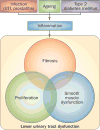Prostatic fibrosis, lower urinary tract symptoms, and BPH
- PMID: 23857178
- PMCID: PMC5625295
- DOI: 10.1038/nrurol.2013.149
Prostatic fibrosis, lower urinary tract symptoms, and BPH
Abstract
Lower urinary tract symptoms (LUTS)--constituting a spectrum disorder that encompasses weak stream, nocturia, and sensations of incomplete emptying and intermittent or hesitant urination--are indicative of lower urinary tract dysfunction (LUTD). LUTD is a progressive disease that can lead to bladder dysfunction if left untreated or treated ineffectively. Sequelae include urinary retention, recurrent UTI, bladder calculi, and, eventually, renal impairment. LUTD involving the prostate is associated with both ageing and inflammation. Tissue inflammation resulting from ageing, infection, or other inflammatory disease processes (for example, type 2 diabetes mellitus) is epidemiologically associated with the subsequent development of tissue fibrosis in multiple organ systems, including the prostate. Recent studies show that tissue fibrosis in the lower urinary tract is associated with LUTD, and suggest that fibrosis might be a previously unrecognized pathobiology that contributes to LUTD. Thus, antifibrotic therapeutic agents should be considered as a new approach to efficaciously treating men with LUTD, especially those who don't experience durable responses to 5α-reductase inhibitors or α-adrenergic receptor antagonists.
Figures



References
-
- Wei JT, Calhoun E, Jacobsen SJ. Urologic diseases in America project: benign prostatic hyperplasia. J. Urol. 2005;173:1256–1261. - PubMed
-
- Kupelian V, et al. Prevalence of lower urinary tract symptoms and effect on quality of life in a racially and ethnically diverse random sample: the Boston Area Community Health (BACH) Survey. Arch. Intern. Med. 2006;166:2381–2387. - PubMed
-
- Irwin DE, Kopp ZS, Agatep B, Milsom I, Abrams P. Worldwide prevalence estimates of lower urinary tract symptoms, overactive bladder, urinary incontinence and bladder outlet obstruction. BJU Int. 2011;108:1132–1138. - PubMed
Publication types
MeSH terms
Grants and funding
LinkOut - more resources
Full Text Sources
Other Literature Sources
Medical

